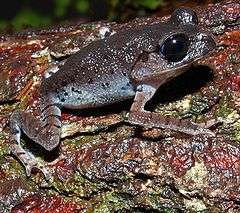Megophryidae
| Megophryidae Temporal range: Late Cretaceous to Recent, 77–0 Ma | |
|---|---|
 | |
| Java spadefoot toad (Leptobrachium hasseltii) | |
| Scientific classification | |
| Kingdom: | Animalia |
| Phylum: | Chordata |
| Class: | Amphibia |
| Order: | Anura |
| Suborder: | Mesobatrachia |
| Superfamily: | Pelobatoidea |
| Family: | Megophryidae Bonaparte, 1850 |
| Genera | |
|
About 9, see text | |
 | |
| Global range (black) | |
The Megophryidae (commonly known as the litter frogs) are a large family of frogs native to the warm southeast of Asia, from the Himalayan foothills eastwards, south to Indonesia and the Greater Sunda Islands in Maritime Southeast Asia, and extending to the Philippines.[1] As of 2014 it encompasses 180 species of frogs divided between 9 genera.[2] For lack of a better vernacular name, they are commonly called megophryids.
The megophryids are notable for their camouflage, especially those that live in forests, which often look like dead leaves. The camouflage is accurate to the point of some having skin folds that look like leaf veins, and at least one species, the long-nosed horned frog (Megophrys montana) has sharp projections extending past the eye and nose, which disguise the frog shape.[1]
Megophryids range in size from 2 to 12.5 cm (0.79 to 4.92 in) in length. The adults' tongues are noticeably paddle-shaped. Their tadpoles can be found in a variety of waters, but especially ponds and streams. The tadpoles are extremely diverse in form because of the variety of habitats they inhabit.
The origin of this group of frogs was largely unknown, due to the lack of members of this family in the fossil record. While the family was originally considered to have originated in the early-mid Cretaceous (100-126 mya) via fossils of related frog groups, a study in early 2017 revealed that this was likely an overestimation. Using DNA sequencing, the study indicated the group more likely originated much later during the Cretaceous period, around 77 mya. The study also indicated that there are likely many more new species in the family that are currently unknown to science.[3]
Genera
Family Megophryidae includes the following nine genera:[2]
- Borneophrys Delorme, Dubois, Grosjean & Ohler, 2006 (rough horned frogs, formerly in Megophrys)
- Brachytarsophrys Tian and Hu, 1983 (Karin Hills frogs)
- Leptobrachella Smith, 1925 (Borneo frogs)
- Leptobrachium Tschudi, 1838 (Eastern spadefoot toads)
- Leptolalax Dubois, 1980 (Asian toads)
- Megophrys Kuhl and Van Hasselt, 1822 (Asian horned toads)
- Ophryophryne Boulenger, 1903 (mountain toads)
- Oreolalax Myers and Leviton, 1962
- Scutiger Theobald, 1868 (cat-eyed toads)
Of these, Borneophrys is monotypic. Genera no longer recognized include Atympanophrys (now in Megophrys) and Vibrissaphora (now in Leptobrachium). Furthermore, genus Xenophrys Günther, 1864 has recently been merged to Megophrys to resolve the paraphyly of Xenophrys, awaiting a better solution. This makes Megophrys the most speciose genus within Megophryidae.[2] However, other sources continue to recognize Xenophrys.[4]
References
- 1 2 Zweifel, Richard G. (1998). Cogger, H.G.; Zweifel, R.G., eds. Encyclopedia of Reptiles and Amphibians. San Diego: Academic Press. p. 88. ISBN 0-12-178560-2.
- 1 2 3 Frost, Darrel R. (2014). "Megophryidae Bonaparte, 1850". Amphibian Species of the World: an Online Reference. Version 6.0. American Museum of Natural History. Retrieved 18 January 2014.
- ↑ "https://www.sciencedaily.com/releases/2017/02/170223114828.htm". www.sciencedaily.com. Retrieved 2017-02-26. External link in
|title=(help) - ↑ "Megophryidae". AmphibiaWeb: Information on amphibian biology and conservation. [web application]. Berkeley, California: AmphibiaWeb. 2014. Retrieved 1 April 2014.
| Wikimedia Commons has media related to Megophryidae. |
- Cogger, H.G; Zweifel, R.G. & Kirschner, D. (2004): Encyclopedia of Reptiles & Amphibians (2nd ed.). Fog City Press. ISBN 1-877019-69-0
- Heying, H. (2003): Animal Diversity Web – Megophryidae. Retrieved 2006-MAY-08.
Further reading
- "Asian Toadfrogs (Megophryidae)". Amy Lathrop. Grzimek's Animal Life Encyclopedia. Ed. Michael Hutchins, Arthur V. Evans, Jerome A. Jackson, Devra G. Kleiman, James B. Murphy, Dennis A. Thoney, et al. Vol. 6: Amphibians. 2nd ed. Detroit: Gale, 2004. p109-117.